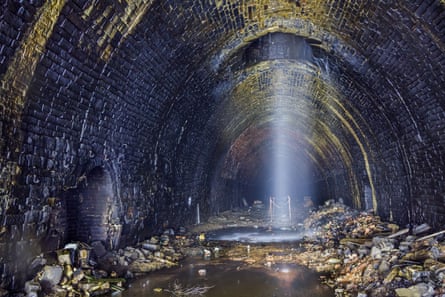Efforts to Transform Historic Railway Tunnel into Cycling Path Face Government Opposition
Advocates aiming to repurpose a neglected railway tunnel into the longest cycling and pedestrian passage in england are contesting a governmental ruling that mandates filling much of this historic structure wiht concrete.
This month, government officials allocated several million pounds towards permanently sealing off the Queensbury tunnel, which dates back to the 1870s and was originally part of a railway connecting halifax and keighley in west Yorkshire. This decision comes despite an investment of £7.2 million just four years ago aimed at reinforcing the structure.
government’s Safety Concerns vs. community Aspirations
The government has sanctioned funding for plans proposed by National Highways (NH), the agency tasked with maintaining ancient rail assets, to infill the tunnel citing safety concerns. This move follows importent backlash against NH for what critics have labeled “cultural vandalism,” particularly regarding previous actions taken on Victorian bridges within the railway estate. Earlier this year, NH had to retract its decision to encase another Victorian bridge in concrete as part of a project intended to connect two heritage rail lines.

Local Leaders express Disappointment Over Decision
The Mayor of West yorkshire, Tracy Brabin, who has been vocal about reopening the 1.4-mile-long tunnel that ceased operations in 1956, expressed her dissatisfaction with this recent governmental choice. In 2021, while visiting the entrance of this historic site, she referred to plans for an underground cycling route linking Bradford and Keighley with Halifax as an invaluable asset for local residents.
Civic advocates have accused authorities of “investing in destruction” while disregarding over 8,000 objections from community members regarding plans for infilling. Thay are scheduled to meet Lilian Greenwood next week—who oversees road policies—to persuade her to reconsider this decision.
Financial Justifications Under Scrutiny
In correspondence with campaigners, Greenwood stated that transforming the tunnel into a cycling path would be prohibitively expensive given “the challenging fiscal environment,” emphasizing that safety issues must be prioritized.

Photograph: Graeme Bickerdike/Four by Three
A balancing Act Between Safety Measures & Community Needs?
Brabin acknowledged shared disappointment among campaigners but also recognized reasons behind governmental action stating: “To ensure public safety required prompt measures securing site conditions amidst financial constraints necessitating tough choices.”
She reiterated commitment towards supporting alternative pathways facilitating walking/cycling connections between both regions.
A Department spokesperson commented:“Given ongoing deterioration observed at Queensbury Tunnel coupled absence local funding options available developing transport links; National Highways instructed undertake necessary works ensuring public safety remains paramount.”
“This represents difficult yet essential decisions made balancing responsibilities toward taxpayer value alongside safeguarding lives.”
